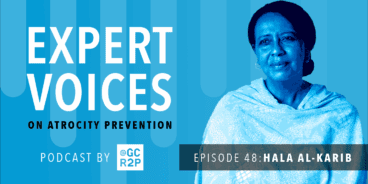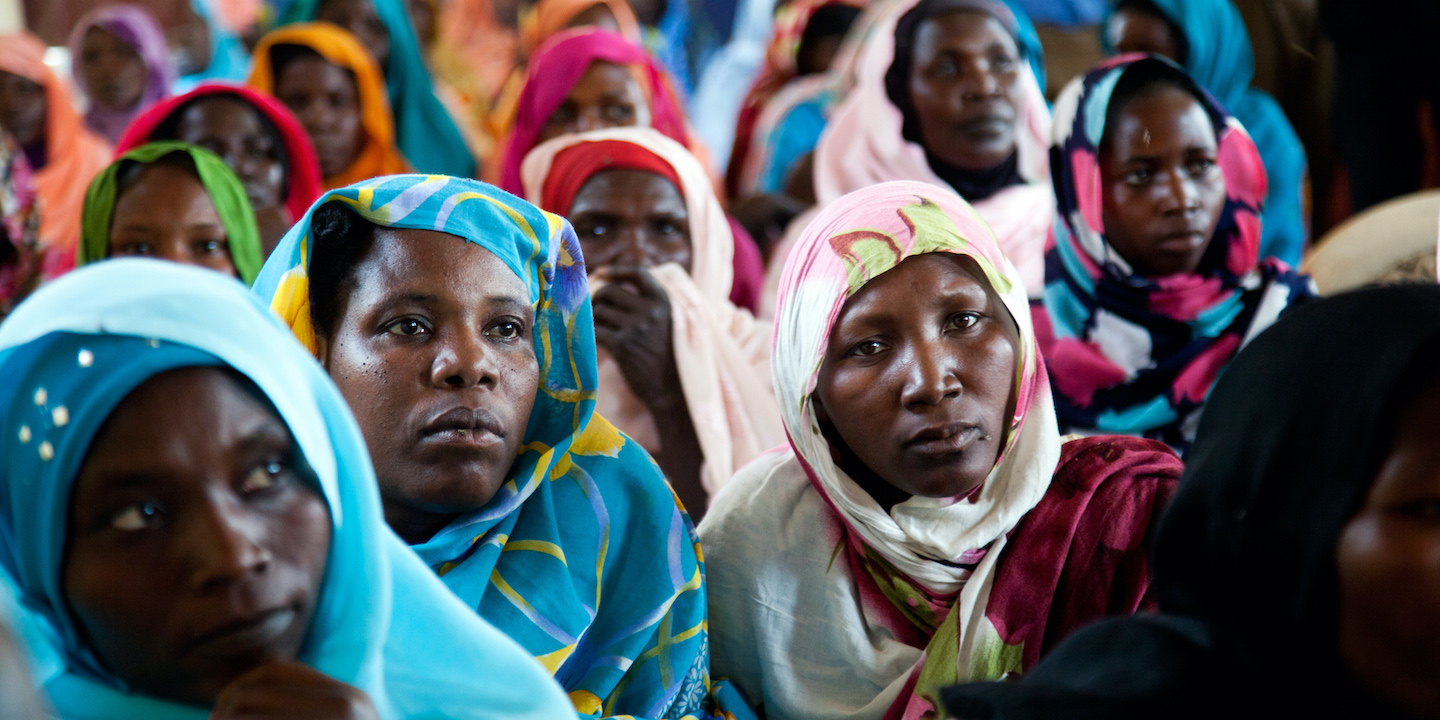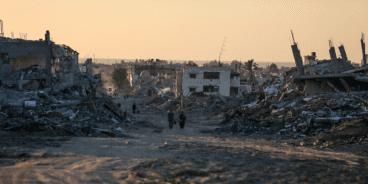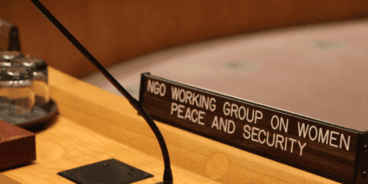

Summary of the UN Secretary-General’s 2020 Report on R2P, Prioritizing prevention and strengthening response: Women and the responsibility to protect
The 12th report of the UN Secretary-General on the Responsibility to Protect (R2P), entitled “Prioritizing prevention and strengthening response: Women and the responsibility to protect,” focuses on the gendered dimension of atrocity prevention and R2P. In particular, the report explores the link between R2P and the Women, Peace and Security (WPS) agenda, as well as the unique ways in which certain atrocity crimes affect women.
On the occasion of the 15th anniversary of the adoption of the Responsibility to Protect, as well as the 20th anniversary of UN Security Council (UNSC) Resolution 1325 on Women, Peace and Security, the Secretary-General emphasizes that this report is intended to enhance understanding of the gendered dynamics of atrocity crimes and improve effective implementation of R2P. The report recommends several policy steps the UN and its member states should take to prioritize women’s meaningful participation, protection and rights.
KEY POINTS
The Global Centre for the Responsibility to Protect would like to highlight the following key points from the report:
-
- Genocide, war crimes, crimes against humanity and ethnic cleansing all have a gendered impact. UNSC Resolutions 1325 and 1820 have affirmed that “rape and other forms of sexual violence can constitute a war crime, a crime against humanity, or a constitutive act with respect to the crime of genocide.” War crimes and crimes against humanity such as rape, sexual slavery, enforced prostitution, forced pregnancy and enforced sterilization disproportionately affect women and girls. Other acts that disproportionately affect women and girls, including imposing measures intended to prevent births within a group and forcibly transferring children of a group to another group, may also be constitutive acts with respect to the crime of genocide.
- As a result of the gendered nature of these crimes, there is a complementarity between mechanisms that address gender-based crimes and R2P. By preventing and protecting women from sexual and gender-based violence, abduction and other crimes, the UN and its member states can take practical action to uphold R2P.
- Gender-based discrimination and inequality are risk factors that can intensify the negative effects of identity-based conflict, and potentially contribute to atrocity crimes. Early warning systems should include gender-sensitive analysis and sex-disaggregated data. They should also recognize the crucial role that women in communities at risk can play in improving early warning, and in developing policies to confront the root causes of conflict.
- Women play a multitude of roles in atrocity situations and should not be viewed exclusively as victims. Women can play a key role in the prevention of conflict and act as agents of change, as well as potentially act as mediators and peacebuilders. Women may also be perpetrators of atrocity crimes, accomplices and otherwise indirectly support the commission of these acts. States must recognize the various roles that women play and reflect this in all atrocity prevention strategies.
- Women must have equal and meaningful participation in all processes related to early warning, the security sector, conflict resolution, peace operations, peacebuilding, and justice and accountability. The full participation of women in all these areas is essential for any comprehensive approach to the prevention of atrocity crimes. All UN member states must work to ensure that obstacles that prevent women from participating fully in decision-making processes are removed.
- In order to build more effective systems to prevent the commission of atrocity crimes, constructive steps to increase participation and representation of women must be simultaneously undertaken at local, national, regional and international levels.
SECTION II: GENDER EQUALITY AND THE RESPONSIBILITY TO PROTECT
In this report the Secretary-General highlights that effective implementation of R2P requires advancing gender equality throughout the prevention and mitigation of atrocity risks. In practice, this may include:
Strengthening risk analysis with gender-sensitive indicators and sex-disaggregated data. Gender-based discrimination and inequality are risk factors for atrocity crimes, and therefore including gender-sensitive indicators and collecting sex-disaggregated data is integral to supporting early warning and establishing an inclusive systematic approach to prevention. The report also notes that when analyzing the causes, consequences and risks of atrocity crimes, it is critical to understand situations where women have played active roles as facilitators or perpetrators of crimes.
Ensuring women’s equal and meaningful participation. The full and equal participation of women in peace processes and in decision-making, as well as in the design of preventive measures, is important in closing any gender-based gaps in atrocity prevention.
Promoting the protection of women and girls from human rights violations through regional and sub-regional mechanisms.Various regional organizations have developed frameworks to promote the protection of women and girls. These regional and sub-regional measures for gender-sensitive prevention are also crucial to ensuring the prevention of atrocity crimes.
SECTION III: THE IMPACT OF ATROCITY CRIMES ON WOMEN AND GIRLS
The Secretary-General highlights that “while progress has been made in recognizing the impact of conflict-related sexual violence on women and girls… it is important to recognize that all the atrocity crimes in the Responsibility to Protect agenda have a gendered perspective and impact.”
War crimes and crimes against humanity, as defined in the Rome Statute of the International Criminal Court, include acts that disproportionately affect women and girls such as rape, sexual slavery, enforced prostitution, forced pregnancy and enforced sterilization. The report also notes that three of the five acts defined in the Convention on the Prevention and Punishment of the Crime of Genocide – causing serious bodily or mental harm, imposing measures intended to prevent births within a group, and forcibly transferring children of a group to another group – are more likely to be directed against women and girls.
The Secretary-General details three areas in which women and girls are particularly vulnerable or disproportionately affected in atrocity situations:
Rape and sexual violence. The Secretary-General notes that sexual violence remains a major threat to women and girls in many situations of armed conflict around the world. In 2019, 19 situations were reported to the Security Council where over 50 parties to armed conflict reportedly perpetrated rape and other forms of sexual violence. The report emphasizes that it is no longer disputed that widespread or systematic sexual violence may constitute atrocity crimes, citing UNSC Resolutions 1612 and 1820, which declared that rape and other forms of sexual violence can constitute war crimes, crimes against humanity or constitutive acts of genocide, and that member states have a responsibility to prevent these crimes.
Trafficking. The Secretary-General notes that the prevention of trafficking of vulnerable people is relevant to R2P, as trafficking for the purposes of sexual exploitation can constitute war crimes. Women and girls are disproportionately affected by human trafficking, accounting for 72 percent of all victims.
Displacement. The report highlights that women and girls are disproportionately affected by displacement in situations of armed conflict and atrocity crimes. Displaced women are particularly vulnerable to sexual and gender-based violence, human trafficking and violations of basic human rights while also lacking sufficient access to nutrition and medical support.
These and other atrocity crimes can cause long-term physical and psychological damage on both individual survivors and the societies where they live. The report notes that survivor-centered approaches to medical and psychosocial services, redress and reparations must be prioritized by states.
The Secretary-General underscores that whilie combatting impunity and ensuring accountability for atrocity crimes are essential to advancing R2P, serious gaps remain in states’ willingness or ability to hold perpetrators of crimes against women and girls accountable and calls on UN member states to do more to end impunity for these crimes.
SECTION IV: VITAL ROLES OF WOMEN IN PREVENTION AND PROTECTION
The Secretary-General emphasizes that a holistic approach to atrocity prevention will only be possible with the equal and meaningful participation of women at all levels and stages. The report outlines particular areas in which participation of women is crucial:
Early warning. Local actors are vital in the early stages of atrocity prevention, including through monitoring and documenting violations, information sharing, facilitating legal redress and supporting survivors. The Secretary-General notes that despite their crucial role, attacks against women human rights defenders continue to rise, including physical assaults, denial of medical treatment, threats to their families and communities, public defamation, media attacks against their physical appearance, arbitrary detention, sexual and gender-based violence and extrajudicial killings.
Security sector. The report notes that based upon UN experience in crisis settings, a gender-balanced security sector – including police, military and judiciary – leads to improved civilian protection and respect for the rule of law. UN data has also shown that employing more women on the frontlines of service delivery, and at the highest levels of policy development, can create a more gender-responsive justice system.
Conflict resolution and peace processes. Global data has shown peace processes that include women as equal partners tend to produce a more sustainable, lasting and just peace. The participation of women increases the probability of a peace agreement lasting at least two years by 20 percent, and the probability of the agreement lasting 15 years by 35 percent. The Secretary-General highlights steps taken by the Department of Political and Peacebuilding Affairs to overcome obstacles to women’s meaningful participation in UN-led mediation efforts and in ensuring women civil society leaders are integral to peace processes at all levels. The report cites examples of peace agreements that included women in the negotiation process and consequently resulted in provisions on the rights of women, the prevention of sexual and gender-based violence, and addressing structural discrimination against women and members of the LGBTQIA+ community.
Peace operations. The report states that the participation of women in peacekeeping contributes significantly to the success of the mission, as women peacekeepers expand the personnel skill range and can enhance the mission’s credibility with the local population. However, the Secretary-General notes that women remain a distinct minority within UN peace operations and calls upon troop and police contributing countries to increase the number of women deployed.
Peacebuilding and sustaining peace. The full and equal participation of women in peacebuilding and development processes is central to sustainable peace and development efforts. Inclusion can also reverse gender inequalities and address the needs of women. The Secretary-General highlights that women have come together as agents of change, mediators and peacebuilders despite the systematic exclusion and personal threats they face.
Justice and accountability. In order to ensure non-recurrence of atrocity crimes, accountability and redress are crucial. The report notes that women’s participation in accountability processes has helped promote gender equality, challenge stereotypes and shed light on the criminal nature of acts of sexual violence against women during conflict. The Secretary-General underscores that it was the meaningful participation of women that ensured the Rome Statute of the International Criminal Court codified a range of gender-based crimes as crimes against humanity and war crimes. However, there continues to be a gender imbalance in international courts and tribunals.
The report notes that despite their under-representation, women across the world are leading as activists and agents of atrocity prevention. The Secretary-General calls on the international community to overturn obstacles that prevent women from realizing their full, equal and meaningful representation.
SECTION V: CONCLUSIONS
The Secretary-General concludes by reiterating the numerous obstacles that women encounter, including underrepresentation, social pressures, stigmatization, abuse and exploitation. For these reasons, the report concludes that the international community is far from its goal of consistently implementing a holistic and effective approach to atrocity prevention. To achieve this objective, member states must strengthen gender equality as part of atrocity prevention and ensure women’s participation as a key element of fulfilling their responsibility to protect populations against atrocity crimes. The Secretary-General calls on all member states and regional and sub-regional organizations to implement a set of recommendations in this regard:
- Recommit to prevent and respond to atrocity crimes and reaffirm paragraphs 138 and 139 of the World Summit Outcome Document, including by addressing gendered aspects of R2P.
- Strengthen gender-based atrocity prevention by enhancing cross-cutting partnerships with other agendas.
- Utilize the Global Network of R2P Focal Points and WPS networks to mainstream gender-based atrocity prevention at the national and regional level.
- Increase efforts to end impunity for atrocity crimes by ratifying and implementing relevant international treaties and conventions, amending national legislation when required, improving access to justice for women and girls, and supporting regional and international accountability mechanisms.
- Develop and include gender-specific indicators in national and regional early warning frameworks and strengthen support for women’s organizations that provide timely and actionable information on emerging risk factors.
- Create environments that enable civil society to help advance protection and prevention efforts.
- Implement measures to address and counter gendered hate speech and incitement.
Related Content


